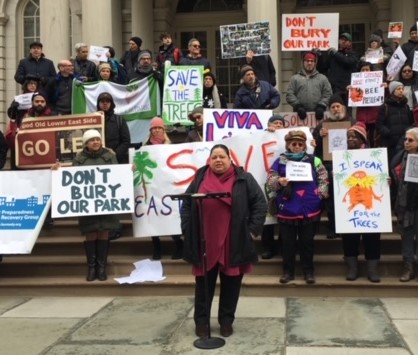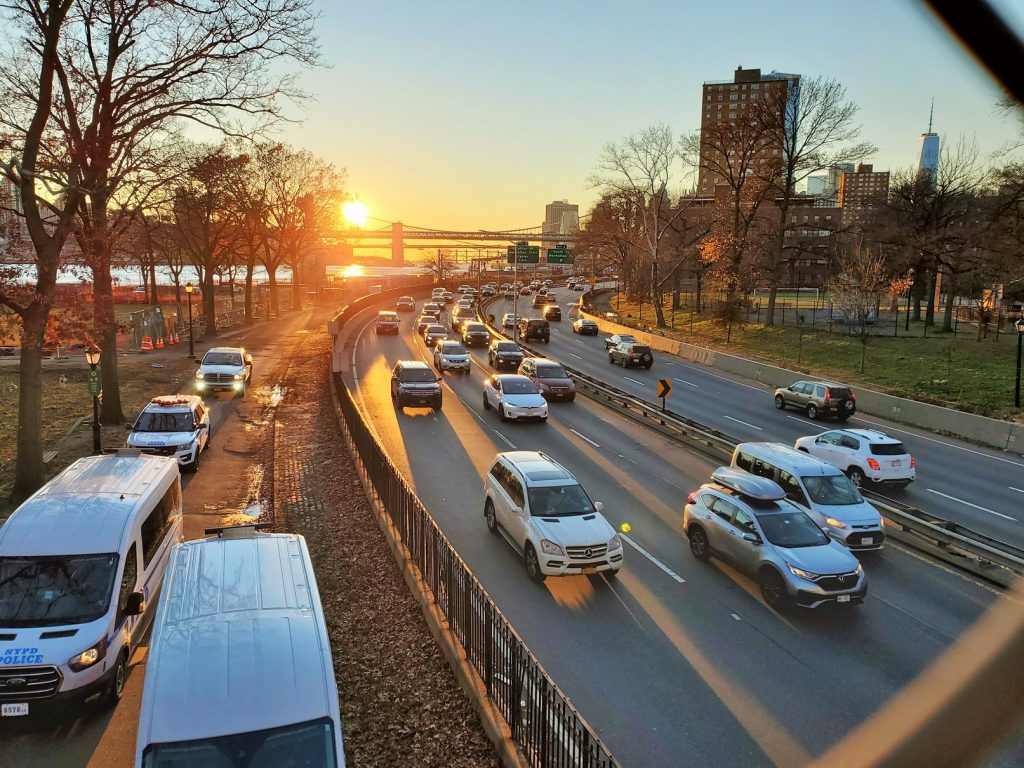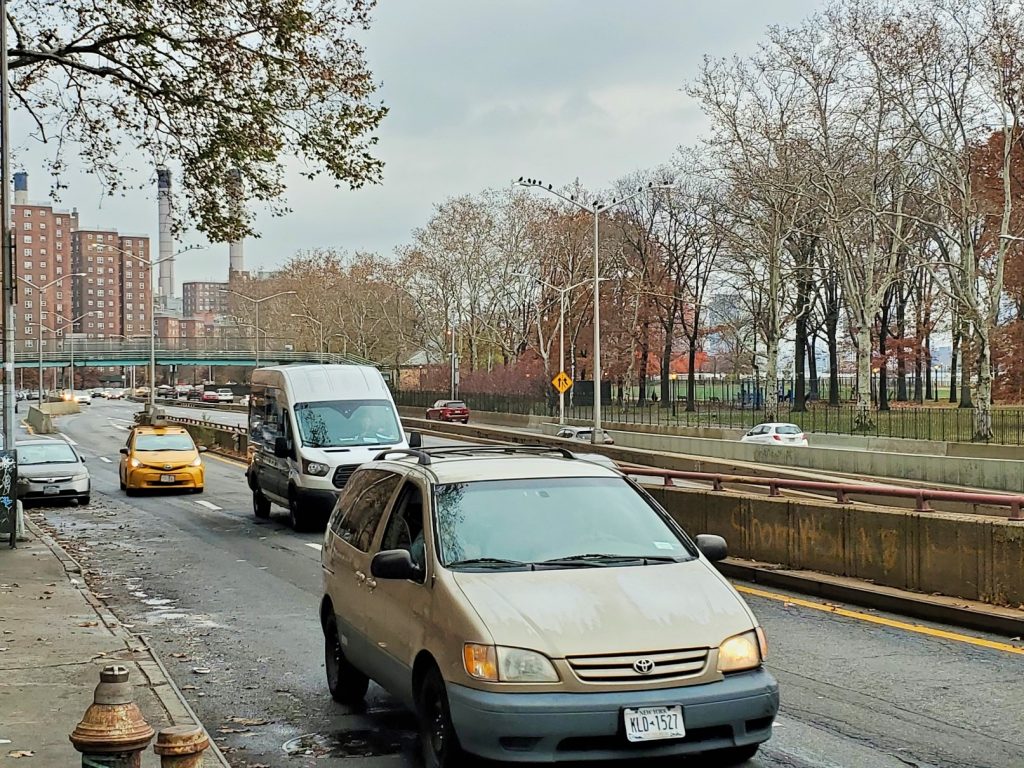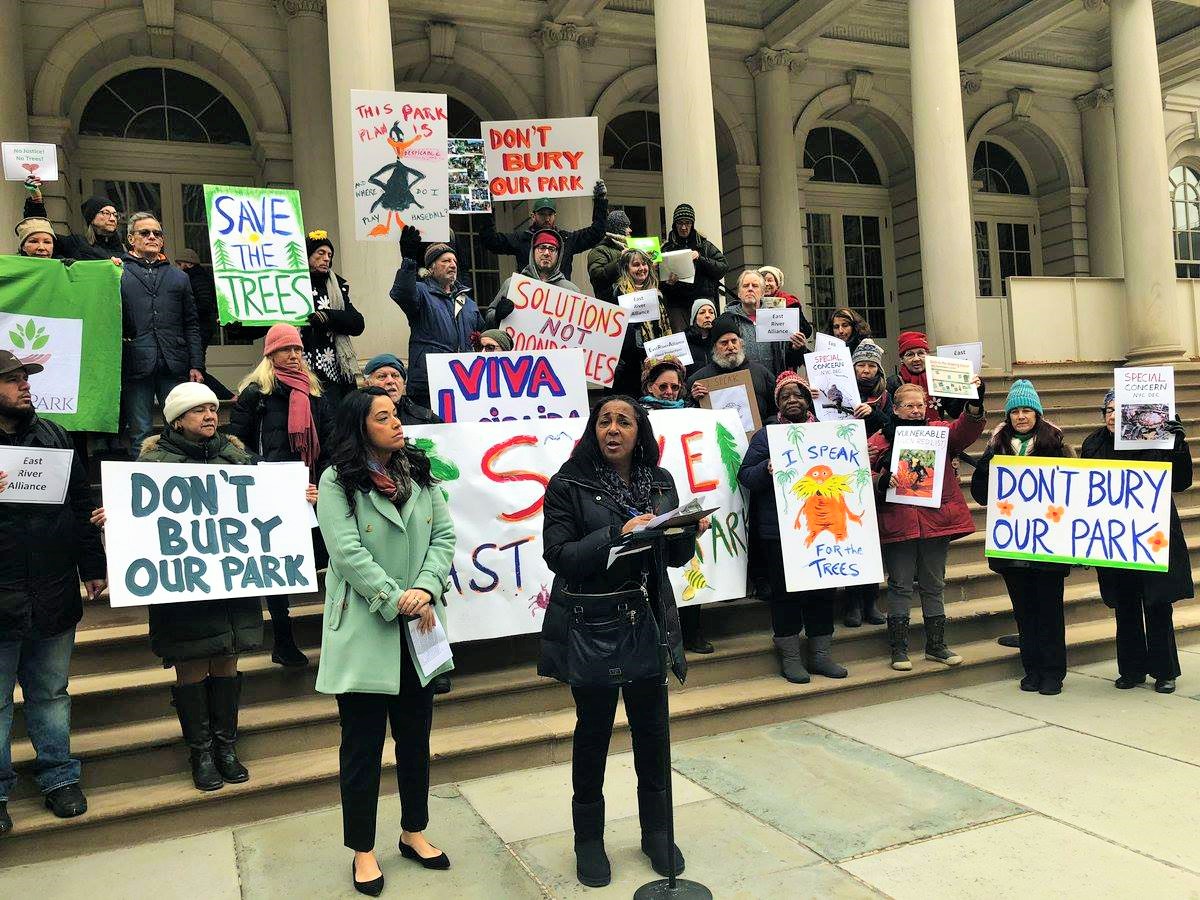BY HOWARD BRANDSTEIN | Deconstruct the video of the “Frontline Communities Coalition” rally on Dec. 18 and what you see is an image makeover for supporters of the de Blasio plan that is now obliterating East River Park despite wide community opposition.
It is certainly interesting how speakers at the rally evade the history of this controversy with repeated shouts of “no more delays.” In their view, opponents of the plan are to blame for this, not the Frontline members’ surrender to de Blasio’s scheme, which nullified four years of planning and participation by hundreds of community residents, many of them people of color, and the work of multiple architectural and design firms. One would be surprised to learn that GOLES, the rally’s organizer, was the lead community agency in this Department of Housing and Urban Development (HUD)-funded initiative during the years 2014 to 2018.

Had the earlier community plan moved forward, we would now be far along in the construction of flood protection for our Lower East Side and East Village neighborhoods. It is true that opponents of the current plan delayed construction for about one month as a result of obtaining a court-ordered temporary restraining order. But it is also true that supporters of the de Blasio plan enabled delays of more than TWO YEARS while the city started from scratch to design its new plan and publicize it in a whole new round of meetings and negotiations with community stakeholders.
In misdirecting their blame for construction delays, rally speakers not only focused their ire on alleged disruptive outsiders but raised the specter of environmental racism in the opponents’ actions. The emergence of the phony trees-versus-people debate reappears, but this time in the language of a “non-resilient” park that offers no protection to frontline communities of color, and which therefore must be destroyed for a new “resilient” park. The history of the rally organizers’ own actions in abandoning the state-of-the art community plan is erased along with the NYCHA Speaks petitions opposing the de Blasio plan, which were signed by about 2,000 New York City Housing Authority residents, largely people of color.

Earlier statements by some supporters implying that NYCHA residents did not have the ability to distinguish between two flood-control plans, one of which completely destroys the park, is of course deeply racist. One cannot point to any accounts of petition signers in mostly white communities (for example, opposing the Noho/Soho rezoning or 250 Water St. tower) being characterized as unable to comprehend what they were signing.
It’s important to bear in mind that the actual effectiveness of the flood-control component of the community plan (a landscaped berm running along the western edge of the park) relative to the flood protection offered in the de Blasio plan was NEVER AT ISSUE. It was the “externalities,” i.e., the closure of one lane of traffic on the F.D.R. Drive, protection of Con Ed power lines and a limited Parks Department budget that were proffered as reasons for canceling the community plan.
These points have been extensively debated, but suffice it to say that, fundamentally, the de Blasio plan solidifies the current climate-wrecking, fossil-fuel energy paradigm, even as we face catastrophic climate change. Spending $1.5 billion on so-called “resiliency” and zero dollars on actual mitigation of pollution and greenhouse emissions does not bode well for the health and well-being of frontline NYCHA residents nor our collective survival.

The struggle over the plan for East River Park mirrors the larger national debate around the direction of planning in our new age of climate chaos. Will we continue to fight the last war (Hurricane Sandy) and view flood control solely from the lens of infrastructure “needs”? Or will we strive for something far more comprehensive, such as a Green New Deal that connects infrastructure with the larger issue of climate change? Biden’s infrastructure and Build Back Better legislation was an important, albeit modest, step in this direction. The sabotage of the latter bill by Joe Manchin reduced Biden’s legislative vision to the sound of one hand clapping.
De Blasio (our local Manchin), in canceling the earlier plan for East River Park, similarly torpedoed the community ethic that working with nature and not against it is our best hope of dealing with the climate crisis. Saving as many trees as possible, expanding the park by decking over the F.D.R. Drive and addressing greenhouse emissions from the 130,000 cars traveling the Drive every day might just be a better approach.
Instead half the park is now a wasteland and dead zone. Every plant and animal that made that piece of the park their home is destroyed because, as one supporter declared at a Community Board 3 meeting, “people are more important than trees.”
Brandstein is executive director, Sixth Street Community Center.


How much safety will an 8-foot-height increase of East River Park really get us? Climatologists predict that if all the glaciers melt because of global warming, the seas will rise 270 feet! However, that might not happen before the beginning of the next Ice Age, supposedly around the year 3500. Apparently the height of the current Ice Age cycle was 12,000 years ago, when most of NYC was under a 2-mile-thick sheet of ice!
We should be following the example of the Dutch, who centuries ago realized that the sea was rising around their sea-level country and pro-actively protected themselves with improved drainage and building dykes and barriers to keep out the sea. Meanwhile, Venice did nothing and many of its oldest buildings now have swimming pools in what used to be ground floors.
Suggestion — Why not take all the indestructible plastic waste we complain about and turn it into big, interlocking waterproof blocks that we can use around Manhattan as a sea wall that can be continually built higher as the need arises, and then taken down as circumstances dictate? And leave the trees alone. Wishful thinking?
Season’s Greetings to All and wishes for a Safe and Healthy New Year.
SPOT-ON, as ALWAYS, Howard Brandstein.
A voice of reason in a sea of madness.
NYC just lost 80% of its carbon-free power when it plugged into fracked gas to serve the interests of a notorious venture capital fracking company that was bribing state officials and filling the campaign coffers of both Democrats and Republicans in NYS, while all of our politicians, including de Blasio, looked the other way. De Blasio was directly informed about this and he didn’t give a ____. NYC is the 2nd largest consumer of power in the entire world, and 80% of our power that used to be carbon-free is now all gas at a global warming rate of over 100X CO2. None of our politicians have any credibility on climate change, so it’s clear that there is some other agenda here. There was no need for the park to be destroyed and this does appear to be a land grab. Crisis capitalism strikes again while sowing division in our community. Ordinary community members without a politicial agenda know how vital the park is to life in the neighborhood on a daily basis. The takedown of mature trees was not only unnecessary but an ecological crime. The race-baiting narratives being used to cover up these crimes are disgusting.
LES3025: “The number of trees in East River Park or the number of cars on the FDR Drive has absolutely zero effect on global emissions, rising temperatures and sea levels and increasingly severe weather caused by climate change.”
Really. I guess you’ve added a degree in Environmental Science and Climate Change to your resume.
You do not need a degree to understand the scale of climate change and that national and global policies are what is needed to affect it. A literal child could understand this.
Thank you very much, Howard Brandstein! De Blasio and Rivera’s approach can be summed up as “maximum pollution for lower-income neighborhoods.” Compare that to the solution found for the wealthy West Siders. Mayor-elect Adams, Congresswoman Maloney, you’re very quiet on this subject!
Thanks to Howard Brandstein for getting it right and putting the issue in perspective. Bill de Blasio has spent eight years carrying out Bloomberg’s fourth term, and the destructive tactic of destroying as much of the park as possible to create “facts on the grounds” during the days when it was unclear if the temporary restraining order was in place speaks loudly as to de Blasio’s mindset and what he thinks of the community.
De Blasio has shown the same contempt for neighborhood people working on neighborhood issues as Bloomberg did. See all those 45-story buildings full of million-dollar condos across the East River? Neighborhood groups in Williamsburg and Greenpoint spent years developing a plan to revitalize the waterfront there, and then Bloomberg rammed through a rezoning that completely ignored those years of work. What was largely still a working waterfront was wiped out, with all the jobs, so that a handful of developers could profit enormously off the cachet of the neighborhoods.
Rivera, The Mayor and the NY Times did a great disservice to the community by making the issue about dividing the communities rather than discussing this horrible plan and that it is what we must settle for.
Rivera / Epstein / Kavanagh / Hoylman: Why is there NO ENVIRONMENTAL OVERSIGHT for what is being done currently? How does this HELP NYCHA Residents.
Brandstein’s thoughtful, concise commentary is precisely what is needed in the general argument over the LES park. His talking point spells out the true nature of de Blasio’s defenders in the East Side park’s (unnecessary) destruction. De Blasio equals Manchin, spot-on.
LES3025: “No reduction in greenhouse emissions on the F.D.R. Drive or increase in trees in East River Park is going to make any difference at all on the impacts of climate change.”
Huh? Are you kidding? In case you’re serious and you honestly think that, try googling anything about climate change and “urban trees” “urban highways” “heat index” “rainwater absorption” “carbon” “lifespan of concrete floodwalls” “astroturf” “saplings vs. mature trees”….
The number of trees in East River Park or the number of cars on the FDR Drive has absolutely zero effect on global emissions, rising temperatures and sea levels, or increasingly severe weather caused by climate change. Long-term climate policy and short-term resiliency are two completely different things that each need to be addressed.
You neglect to consider micro climates, my friend. Local climate affects global climate. We work for both. Improving local pollution and balancing local climate is important locally and also it happens to be helpful globally.
Trees are the only real carbon-capture technology we have. Trees are vital to local air quality. and NYC’s GHG emissions are foolishly skrocketing because of our increased use of fracked gas. Cut that first and then we might believe you care about the climate.
As I said to Howard previously in the comments of this newspaper, he is presenting a false choice between near-term resiliency and long-term climate action. In reality, the answer has to be both. No reduction in greenhouse emissions on the FDR or increase in trees in East River Park is going to make any difference at all on the impacts of climate change. It’s important to pursue objectives like those as long-term goals, and I fully support tearing down the FDR and vastly reducing vehicle usage through congestion pricing, removing on-street parking, improving bike lanes as an alternate form of transit, and any other means you can think of. But you also have to protect against the next Sandy, because it’s going to happen no matter what we do today and, if we don’t protect the neighborhood, people will be hurt just like they were 10 years ago, possibly worse.
If the “community” plan could have moved forward two years ago I would have been all for it. But it didn’t. I’m not offering an iota of defense of de Blasio and he deserves the blame for wasting time on a plan that didn’t have the necessary buy-in from Con Ed, NYC Parks and whoever else drove the switch to the current plan. And he also deserves the blame for the complete bungling of the community engagement process. But we are where we are, something needs to be done, and this is progress, even if imperfect.
No one standing in the way of this important project now gets to take on the mantle of environmentalism.
Flooding will happen in the future whether by storm surge, or as Ida showed, hard rain that ignores a berm.
There are three defenses that cover both of these scenarios: One: Sewer maintenance, both belowground and also aboveground. This latter did not happen because of constant, flagrant illegal parking blocking streetsweepers without consequence before Ida, so the sewer grates were clogged with trash, making flooding worse than it had to be. I bring this up to point out that no infrastructure will work if city government is hobbled by corruption.
Two: Permeable pavement and greenspace. You say you support tearing up the FDR Drive? Tear it up now! Cut the Gordian knot and attack the real problem, which is all the space wasted on supporting cars: the highway, the giant roadways, the parking lots still earmarked for new construction. There should not be parking lots for public housing in New York City, much less the Lower East Side. That’s an absurd waste of public land.
Three: Building resilience itself. Flooding is inevitable and buildings should be built to resist that. It makes far more sense to place this responsibility on individual structures, using uniform building codes, rather than demanding the public wildly overpay and sacrifice a park to protect a few crappy old buildings and a highway that produces the pollution that poisons its occupants.
And you are showing the scary fake pictures and you don’t blame Con Ed for not keeping their power plant from flooding. The only future they think about is rasing your bill. And blame the city for their sewer system for flooding the basement. If another Ida come and hit the Lower East Side and East Village — we still call it Alphabet City — Avenue C is be a big bathtub where the water can’t go to the river to drain. Then you are going to blame the park again? The park is higher than the neighborhood. Get the facts straight! They are going to build huge 80-story buildings on the waterfront blocking all your sun from morning to evening. Then I’m going to wear a hat saying, “I told you so.”
If that happens I’ll buy you the hat and get myself a sandwich board to wear that says “I was wrong” and we can walk around the neighborhood together.
I can appreciate the “practical” point LES3025 is making regarding moving forward with the de Blasio plan. What they fail to recognize, however, is that there is no more “long-term” available to us. We are at the end of the line; there is no more road left to kick the can down in delaying action to address the climate crisis. Whatever we can do (or not do) we must do (or not do) right now. LES3025 is correct in pointing out that saving 1,000 trees and shutting down the FDR Drive will not reverse climate change. (It will however immediately reduce suffering from asthma and other pulmonary conditions that frontline NYCHA residents experience at some of the highest rates in the city). My point here is that the community plan together with an effort to reduce greenhouse emissions on the FDR Drive can also be a MODEL for other shoreline communities. If enough communities adopt such a plan, then yes we can have an impact in reducing the risk of climate change. I earlier pointed out the absurdity and denialism in the de Blasio plan
https://eastriverparkaction.org/2021/09/10/occupy-east-river-park/ It should be enough to recall that it rained on Christmas just a few days ago, and that this summer in Queens ELEVEN PEOPLE LIVING IN BASEMENT APARTMENTS DROWNED — not from storm surge — but from torrential downpours. (Shall we next construct a giant umbrella dome over Queens?) By the time de Blasio’s “Great Wall” is constructed it will be irrelevant, if it is not already, in affording any protection to our neighborhoods. As I and others have explained, his 19th-century conception of flood control makes our situation worse! The Intergovernmental Panel on Climate Change tells us that by 2030, without dramatic reductions in greenhouse emissions and simultaneous preservation and expansion of green space, we will face irreversible consequences: mass deaths in the 2030s and possible human extinction thereafter.
If the goal is maximalist climate action now, which I think is a reasonable position to take, time would be much better spent lobbying on other issues, such as congestion pricing, transit infrastructure and/or street parking reform. I understand the idea that we’re at the end of the road, even if I don’t quite agree. But, if that is your view, spending finite time and effort on one local project seems like a misuse of resources.
Similarly, the idea that climate change can or should be addressed by individual communities deciding on projects, seems to misapprehend the scope of the issue and solutions. The scale of climate change is so great that we can’t rely on community-level action any more than we can rely on individual-level actions. That is why I said initially that climate-change action needs to focus on the national or even global levels. In my view, local government needs to focus on short-term actions to protect the people there from the impacts. And of course that should include many other improvements, such as sewers and drainage that would have better protected those people in basement apartments in Queens.